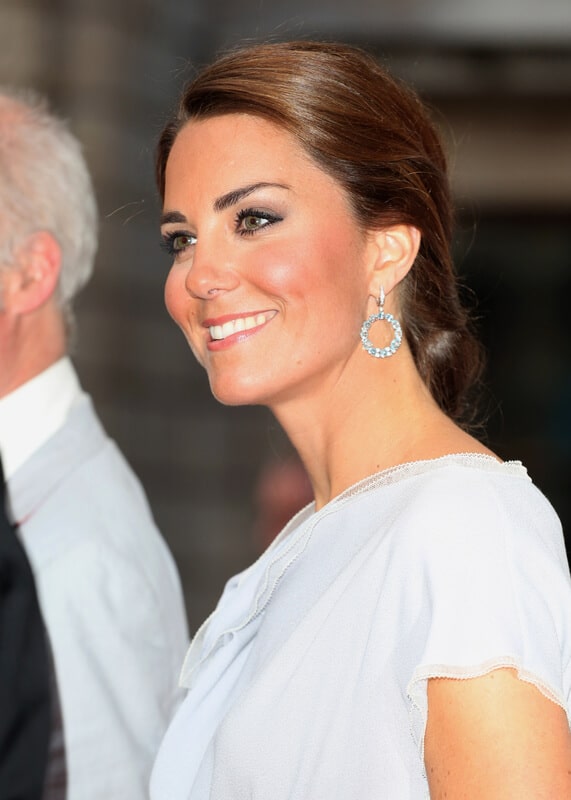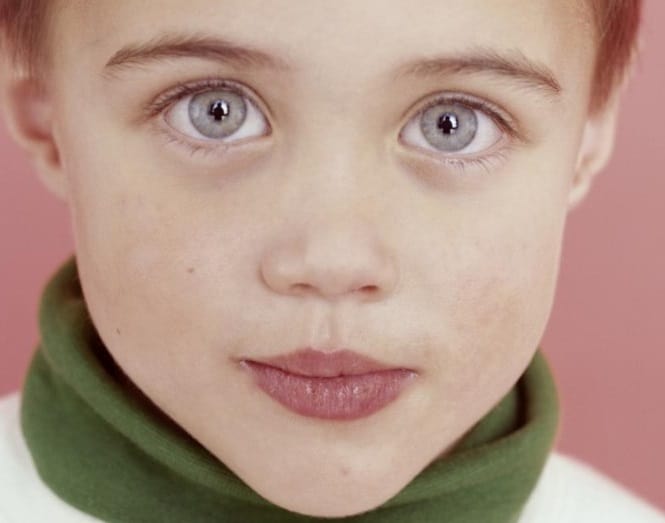I’ve always been fascinated by eye color and why some eye colors are more common than others. I was most curious about the rarest eye colors in the world and if I knew anyone who had this rare color. Are you curious to know whether your eye color is one of the rarest in the world?
What is the rarest eye color in the world? The rarest eye color in the world is green. An estimated 2% of the world’s population has green eyes. Aside from green, amber is also considered as one of the most unusual eye colors in the world. Some say amber is the rarest eye color; however, the general consensus is that green is the rarest eye color.
| Eye Color: | Percentage of World Population: |
| Green | 2% |
| Amber | 5% |
| Blue | 8-10% |
| Brown | 50-79% |
Red or violet is technically the rarest eye color; however, it is extremely rare, caused by a very rare genetic condition called albinism.
Read on to learn more about the rarest eye color in the world, as well as just how rare it is.
What Is the Rarest Eye Color in the World?
Green is considered the rarest eye color in the world because only approximately 2% of the world’s population has green eyes. That’s around 154,000,000 people from the world’s 7.7 billion population – or approximately the population of Russia. [1]
This may be surprising to hear that green eyes are the rarest eye color in the world; however, many people mistaken hazel or blue eyes for green eyes based on how light reflects off the eye.
Several factors affect the color of your eyes, and one of them is heredity. The genes related to green eyes are not dominant and therefore are so rare. Of course, other aspects influence eye color, and we will discuss them as we go along.
The green color appears when the amount of melanin found on the surface of the iris is small. The small amount of melanin reflects a blue color. This blue color then mixes with the yellow color given off by the pheomelanin or lipochrome that is present in the eyes. And when the Rayleigh principle of scattered light is applied, it tends to give off a green color.
Green eyes are rare because genetically, there are fewer people with alleles containing the green color in their genes. Remember that your genes play a vital role in the color of your eyes. A newborn baby will not have green eyes unless they have the needed genes that predispose them to acquire that eye color, such as genes from their parents.
Where Did Green Eyes Originate from and Where are Green Eyes Most Commonly Found
Green eyes originated from Western Asia and in the Northern Southern and Central Europe areas. Green eyes are most observed in women of German or Celtic ancestry. More than 80% of the population of Ireland and Scotland has blue or green eyes.
Also, in Iceland, more than 85% of men and women have either blue or green eyes, with women at 89%, compared to men at 87%.
Celebrities with Green Eyes

ID 27526243 © Featureflash | Dreamstime.com
Below are some celebrities with rare green eyes:
- Kate Middleton
- Channing Tatum
- Clive Owen
- Emma Stone
- Drew Barrymore
- Adele
- Amanda Seyfried
- Lindsay Lohan
- Eddie Redmayne
- Scarlett Johansson
Some of the Other Rarest Eye Colors in the World

Here are other rarest eye colors in the world:
1. Amber Eyes
Next to green is amber. It is another unusual eye color, so not many people have it. Around 5% of the world’s population has amber eyes. As of April 2019, there are 7.7 billion people in the world. Five percent is roughly 385,000,000 people with amber eyes. [2]
The amber color comes from the yellow lipochrome and the russet color of the eyes that has little amount of melanin. This combination will reflect an amber color.
2. Violet or Red Eyes
Technically, violet or red eyes are the rarest eye color, but it is so extremely rare as it is due to an extremely rare genetic mutation. These eye colors exist when a person has albinism. With albinism, people have insufficient melanin in their eyes, skin, or hair, so their eyes look blue. Because of this lack of pigment, light is bounced off the eyes and reflects the color of the eyes’ blood vessels, which is red-black.
When this red-black color combines with the blue color of the eyes with light scattering, the reflected color can either be violet or red.
3. Gray Eyes
Gray-colored eyes result when there is insufficient melanin in the iris’ front layer. Due to the scattering of light, it reflects the color gray. Gray eyes originated from Eastern and Northern Europe.
4. Blue Eyes
The blue color is reflected because the iris has deficient levels of melanin. People with blue eyes usually come from Europe, especially Finland.
What’s the Most Predominant Eye Color?
We’ve answered the question, “What’s the rarest eye color in the world?”, now let’s look at the most common eye color in the world. The most predominant eye color is brown. The shade of brown in the eyes will depend on the amount of melanin in the iris. The more melanin present, the darker the eye color.
Brown is the most predominant eye color in the world, with almost 79% of the world’s population having brown eyes. Dark brown eyes have originated from East Asia, Southeast Asia, and Africa, while the lighter shade of brown has originated from America, Europe, and West Asia.
Factors Determining Your Eye Color
Several factors could affect your eye color. If you look around you, your physical attributes have something to do with race or ethnicity. The majority of Asians have black hair (sometimes brown) and very dark eyes. On the other hand, most white Americans have fair skin, brown or blue eyes, and aquiline noses.
Europeans have somewhat similar physical features as Americans because of their blue or brown eyes and pointed noses, but there are still differences in their eye colors. Europeans have more striking eye colors than Americans.
Generally, when you have someone in your family who doesn’t look like the rest of you, either he or she must have inherited the traits from your great, great grandparents or has different parents.
These facts point to certain factors that contribute to the physical features of a person. Let’s discuss each one of them. What is the proven science behind the color of your eyes?

1. Genetics
Genetics plays a significant role in the color of your eyes. Most probably, you would have the eye color of your father or mother. It’s because you inherit half of your mother’s genes and half of your father’s genes. Science proves this basic fact.
It could also happen that the color of both of your parent’s eyes would combine to form a new color. There are around 16 types of genes that could determine the color of your eyes. Typically, your eye color would be close to that of your parents or those in your family tree.
Nevertheless, in some recent studies, it has been proven that aside from the genes you inherited from your parents, the onset of multiple genes and genetic variations exert some significant effect on the color of your eyes.
Thus, there could be color variants among family members. The idea that parents with brown eyes can never give birth to a child with blue eyes is no longer valid. Also, having brown eyes is considered dominant to blue eyes, so when they combine, brown will win.
Under normal circumstances, it was a simple combination of the parents’ genes. However, other genes could also determine the color of a child’s eyes, hair, and skin. So a child could get the rarest eye color in the world – green – just by getting the right genes from the parents.
Some of these genes include ASIP, TPCN2, SLC24A4, and TYR. The resultant action of these genes, when combined with HERC2 and OCA2, which are genes located together near chromosome 15 (the major chromosome responsible for eye color), would produce a wide array of colors in various individuals.
For children born from interracial marriages, the combination of the parents’ genes could produce a new color based on their recessive, dominant genes and the minor genes and their alleles (alternative forms) that are responsible for eye color.
One example is a child with blue eyes despite having parents with brown eyes. The reason is that the mother may both have brown and blue alleles in her genes and was able to pass only her blue allele to her child. Therefore, even if the brown allele is more dominant than the blue allele, the child would still have blue eyes.
So, even if the blue allele is recessive and the brown is dominant, if the brown weren’t passed on to you by your mother, you would have blue eyes. Another example is when heterozygous parents with both brown eyes could still produce an offspring with blue eyes. Thus, many factors contribute to the color of your eyes.
This fact applies to all your physical features. You would inherit 50% of your father’s genes and 50% of your mother’s genes. However, take note that based on recent studies, it’s not that simple anymore, as variations in genes could produce unexpected eye and hair colors in a child.
2. Melanin
Melanin also has a primary role in the color of your eyes. So, how does it affect your eye color?
The color of your iris is the basis of your eye color. The iris is the area surrounding the black pupil found at the center of your eyes.
The color of your eyes is in proportion to the quality and amount of melanin in the layers found before your iris–and the more melanin the layer has, the browner your eyes become. In instances when there’s less melanin in your iris, the bluer your eyes would become. Thus, less melanin = blue; more melanin = brown.
The iris is also responsible for controlling how much amount of light can enter your eyes. Eye colors come in an array of colors, depending on your genes and other factors.
Another crucial substance to the production of melanin is the P protein. This type of protein is responsible for producing melanin. Thus, it’s directly proportional to the amount of melanin in the eyes. The less P protein present, the less melanin is produced in the iris, resulting in eyes that are lighter in color, such as blue.
3. Sunlight or Scattering of Light
How light scatters affect the color of your eyes as well. Sunlight can change your eye color because it can increase the production of melanin upon exposure. When your eyes are exposed more often to sunlight, increased production of melanin happens; thus, darkening the color of your eyes.
Increased melanin production will deepen the color of your eyes, making them browner or bluer. Keep in mind that lighter-colored eyes tend to be blue or green, and darker-colored eyes tend to be brown. The scattering of light could also produce a new color when two colors combine.
4. Environment
Aside from your genes, the environment could also affect the color of your eyes. Lighting often affects people with light-colored eyes.
Those staying in an environment that doesn’t have sunlight could sometimes reflect lighter eye colors. The color that your eyes reflect is the color that other people see. That’s why white absorbs all colors, and black reflects all colors.
5. Eye Conditions
- Heterochromia: This condition can be caused by injury to the eyes, certain eye diseases, and genetic changes or dysfunction during the growth and development of the eyes.
- Ocular Albinism: This type of albinism is characterized by the lack of pigmentation in the iris, resulting in lighter-colored eyes. Vision clarity is also affected in most cases.
- Oculocutaneous Albinism: This disorder is caused by the mutation of the genes responsible for producing and storing melanin. The melanin in the iris is insufficient, causing light-colored eyes. The skin and hair are also affected by this condition. They tend to be lighter in color as well.
6. Artificial Eye Color
Numerous people purposely change their eye color by using contact lenses or artificial eye colors. You could use contact lenses to change your eye color, but you have to learn how to take care of your contacts properly. Inadequately cleaned contact lenses can cause eye infections and more severe conditions.
Can Eye Color Change?
Eye color can change depending on the factors as mentioned earlier. Certain genetic disorders and environmental factors, including sunlight exposure, can change a person’s eye color.
Furthermore, some people develop changes in their eye color as they become older. Such changes were observed in Caucasians, wherein 10-15% of them have changed from dark-colored eyes to lighter-colored eyes. The color change could range from brown to a lighter shade of color.
Conclusion – What Is the Rarest Eye Color in the World?
So to revisit our initial question: What is the rarest eye color in the world? The rarest eye color in the world is green, with only 2% of the world’s population having it.
The next rare eye colors are amber and gray. The green eye color originated from the Northern, Western, and Central Europe areas and is gradually spreading. But the most predominant eye color is still brown.
In summary, here are the different eye colors and their percentages.
| Eye Color | Percentage of World Population |
| Green | 2% |
| Amber | 5% |
| Blue | 8-10% |
| Brown | 50-79% |
One could say red or violet is the rarest eye color in the world; however, it is so extremely rare, with very few people having this color due to the rare genetic mutation albinism.
Whatever your eye color is, the most important thing is to have normal, healthy eyes. If you want, you could always change your eye color by wearing contact lenses–but with proper eye and lens care, of course.
Related reading:



![Read more about the article How to Remove a Tick Without Tweezers [Human, Dog, or Cat]](https://skincaregeeks.com/wp-content/uploads/2020/12/how-to-remove-a-tick-from-a-human-without-tweezers-300x200.jpg)

